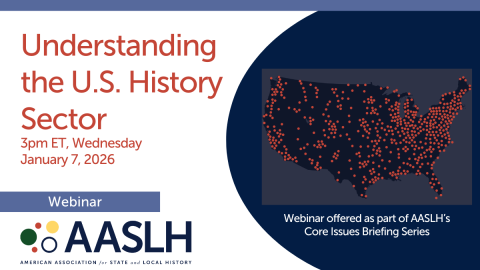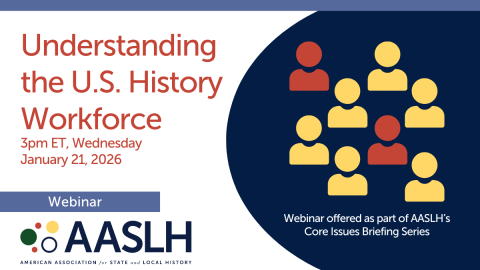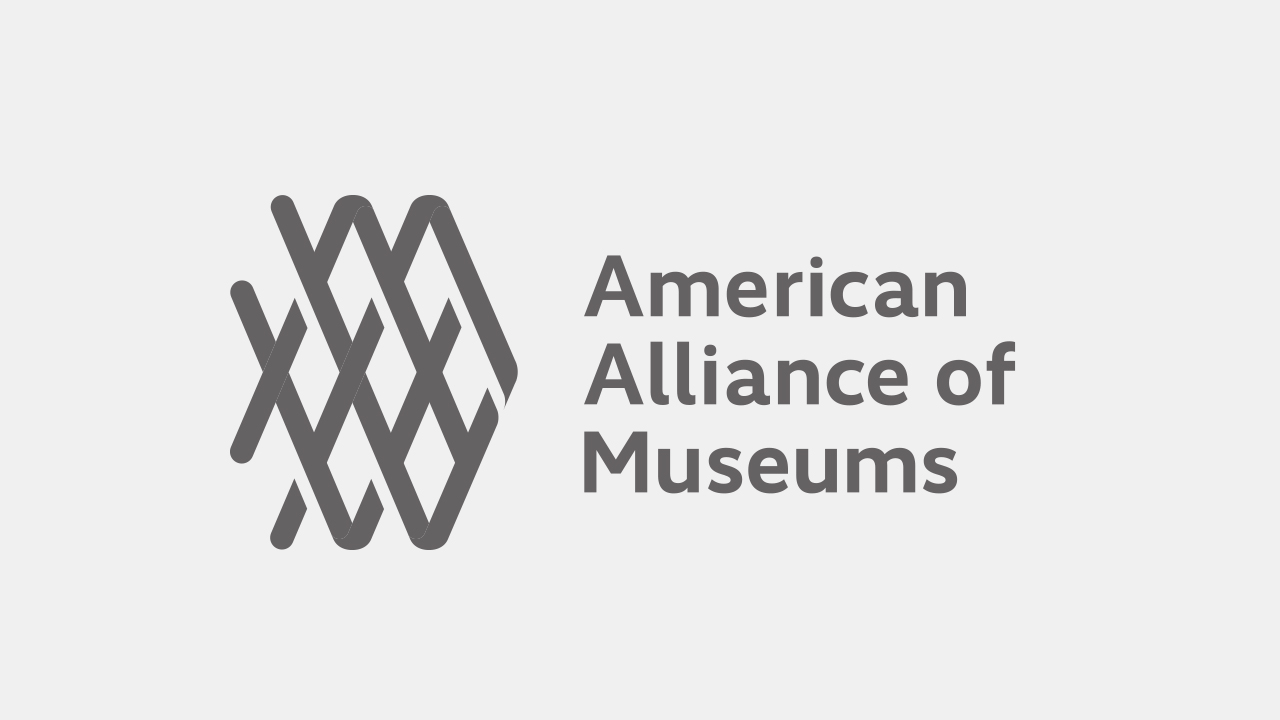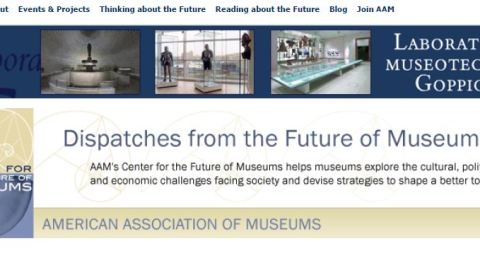
This article originally appeared in the March/April 2018 edition of Museum magazine.
In the science center world, some have debated the relevance and value of makerspaces. They question whether investing in makerspaces is consistent with the educational goals of our institutions.
However, when the Arizona Science Center had the opportunity to establish a community makerspace, we did not hesitate. And we have no regrets.
Arizona Science Center is a place where community members of all ages come for inspiring and engaging science education experiences. Our vision for programming emphasizes hands-on STEM learning opportunities that uncover and celebrate the daily wonders of science, large and small.
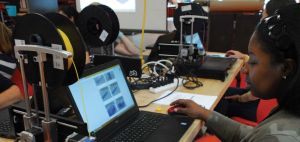
Having a space dedicated to exploration, experimentation, and creation not only aligns with our institutional mission, it allows us to fulfill that mission in new and exciting ways that transcend the typical conception of what museums and science centers offer. In the two years since we opened CREATE at Arizona Science Center®, it truly has become a place where thoughts become ideas and ideas become reality.
Educators from across the state engaged in a five-day Art of Making Boot Camp. They were introduced to the maker mindset, participated in design challenges, and received hands-on training with the technology in the CREATE hubs (electronics, woodshop, and artistry).
How We Built It
After nearly four years of dreaming and goal-setting, in the summer of 2013, we started planning the CREATE makerspace in earnest. From the outset, Chevy Humphrey, The Hazel A. Hare president and CEO of Arizona Science Center, and the governing board members knew the success of this space would depend on its widespread appeal, flexibility, and availability to all community members.
Designing the Space
Early on, the planning team gave a variety of individuals from within and outside the community a voice in the planning and design process for CREATE. The planning team organized a series of charrettes—collaborative sessions to develop solutions to design challenges—that directly involved Arizona Science Center staff and board members, local business owners, architects, college students and professors, engineers, designers, local educators, and science and technology center colleagues from around the globe. The groups gathered to discuss how CREATE could best meet community needs, connect with local businesses, and complement the offerings of other education organizations. These discussions helped the planning team nail down its intentions and goals for CREATE’s institutional impact, operations, community involvement, construction, and design.
After the charrettes, a smaller design group, led by a project manager working with the chief operations officer, formed to oversee the design and construction process. Everything about the design was intentional (down to the signs for each of the resource centers) and was conceived with flexibility and agility in mind.
CREATE has an industrial wood and metallic look, with zones that define each space but do not constrain them. There are open areas for people to chat, tinker, and collaborate and other areas that can be used separately for safety or privacy reasons. Them mobile furniture allows the space to be used for a variety of purposes, from group making activities to meetings and even gala events (thus offering the museum additional revenue streams).
Designing and Adapting the Programming
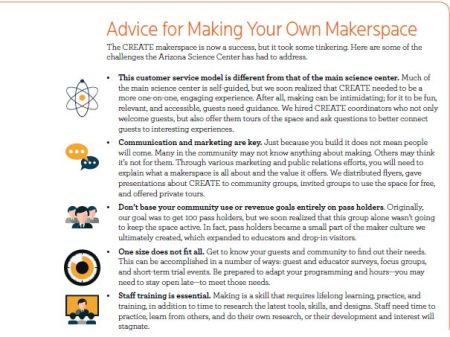
As CREATE’s physical space was being designed and constructed, the planning for its programming and operations was simultaneously underway. Initially, we planned to have CREATE programming available to pass holders, who would take classes and pay a membership fee to use the tools and equipment.
Drop-in visitors and school groups could also engage in various staff-designed “maker challenges” in the three different CREATE zones for a cost that depended on supplies and resources used. In this initial vision, the space would be open to the public during the same hours as the science center.
But as any maker knows, even the best-laid plans don’t always work out as originally conceived. So, in keeping with the adaptive nature of the CREATE makerspace, Arizona Science Center’s approach to programming and operations has been similarly agile. In fact, much of the initial programming model has been modified to better suit how the community uses the space and its resources.
We now have extended hours three days a week, and we offer a broader range of visitor options: “maker experiences,” in which customers choose to make something from a list of items; free tinkering activities; field trips; professional development in making and project-based learning; and long-term afterschool project-based learning opportunities with business experts as mentors.
How We Share What We Know
Even before CREATE’s doors opened, word of our makerspace had spread throughout our Arizona community and to science centers around the world. Groups from other countries were coming to see this makerspace and how it would be incorporated into the existing culture of Arizona Science Center and the community. Humphrey and Dean Briere, chief operating officer of Arizona Science Center, tirelessly explained to all what was happening at CREATE and helped other science centers start their own makerspaces.
We also made a concerted effort to engage school groups. Some groups arrived with an interest in the makerspace movement but didn’t know exactly how to incorporate making into their curricula; other groups were new to the concept. We were able to meet everyone where they were. We also scheduled tours that showcased the CREATE space for educators, principals, and superintendents from across the state and engaged them in making activities so they could understand CREATE’s value.
One of the central goals of the Arizona Science Center is to improve science teaching in the state, and the CREATE makerspace has enabled us to expand our professional development work. In addition to our teacher residency program and workshops for science teachers, through CREATE we have developed professional development partnerships that provide educators with project-based learning opportunities that incorporate making into science education.
In addition, two CREATE professional development modules offered onsite, “Making as a Mindset” and “The Art of Making,” are now earned-revenue streams that help sustain CREATE programming. Our training and consultation work with school districts, in which we help them conduct design charrettes, plan their goals, and design their own makerspaces, is another revenue stream.
Several of the districts we have consulted with have already opened or will be opening, their own makerspaces. We are honored to have been a partner in their journeys. These school site makerspaces will allow students to imagine, design, and create while connecting concepts they learn in school with real-world projects.
This is precisely the kind of science learning our institution has always wanted to inspire and make a reality.
RaeAnn Fox is vice president of programs at the Arizona Science Center in Phoenix, Arizona. She will be a speaker at the AAM 2018 Annual Meeting & MuseumExpo in Phoenix, Arizona on May 6–9, 2018.
